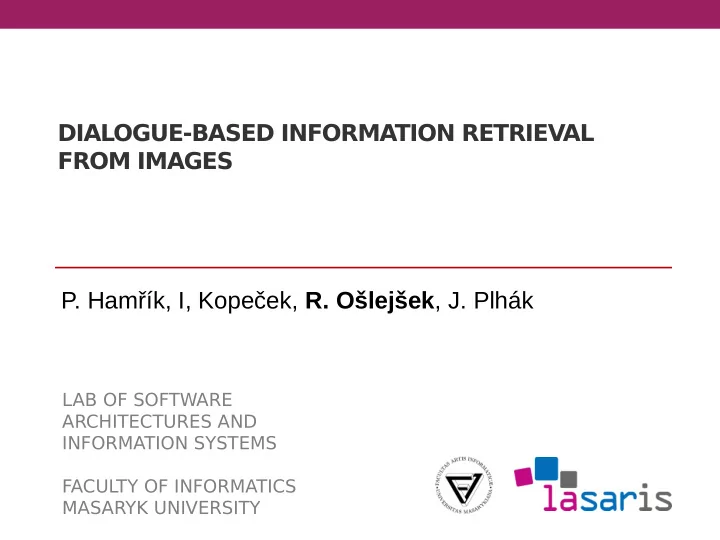

DIALOGUE-BASED INFORMATION RETRIEVAL FROM IMAGES P. Hamřík, I, Kopeček, R. Ošlejšek , J. Plhák LAB OF SOFTWARE ARCHITECTURES AND INFORMATION SYSTEMS FACULTY OF INFORMATICS MASARYK UNIVERSITY
2 R. Ošlejšek, ICCHP'14, Paris Motivation – Communicative Images Communicative image ● An image enabling users to explore its content by means – of dialogues. Window to the depicted world fully accessible through – natural language.
3 R. Ošlejšek, ICCHP'14, Paris Key Principles – Annotated Pictures Semantics: System of OWL/RDF ontologies for picture ● annotation and shared multilingual knowledge. Defjnes grammar of the dialogue system. Graphic format: SVG as fmexible XML wrapper enabling us ● to embed the original raster image together with structured semantics
4 R. Ošlejšek, ICCHP'14, Paris Key Principles – Dialogue Subsystem Restricted grammars (only a small fragment of natural ● language): Generic grammar: “Describe picture.” , “What is in the – picture” , etc. What-Where Language: “Where is object?” , “What is in – the upper-left corner?” . Experimental domain-specifjc grammars: Fine-tuned for – concrete picture. Dialogue frames: templates for questions with slots that ● can be fjlled by specifjc entries from ontologies. “How far is it from SLOT1 to SLOT2?” –
5 R. Ošlejšek, ICCHP'14, Paris Workfmow ● Client (e.g. plug-in to web browser) sends an image to our server The image can be communicative or not – JavaEE server providing REST services – ● Server embeds the image in SVG and do additional preprocessing Auto-detection and image-recognition techniques would – help to gather initial semantics [in development] ● Client sends questions (sentences) to the server, dialogue module parses the questions, inspects ontology and composes answer No intelligence on the client side –
6 R. Ošlejšek, ICCHP'14, Paris Demo ● Exact transcription of our experimental system Adjusted for screen readers: ● – http://lsd.fj.muni.cz/~xplhak/gate/ With styles: ● – http://lsd.fj.muni.cz/~xplhak/virtualgate/
7 R. Ošlejšek, ICCHP'14, Paris Goal 1: identify (hidden) image What is in the middle? There are Philip, Jesus, T able, John, Peter, Thomas, Judas and James Major in the central part. What is Jesus doing? In this picture, Jesus is Sitting. Hwo is author? This painting was created by Leonardo da Vinci. When did Leonardo create the painting? Painting has been fjnished in 1498.
8 R. Ošlejšek, ICCHP'14, Paris Goal 2: Find Judas Judas? Where is Judas? Judas is in the middle of the picture. How Judas looks? In this picture, Judas is Withdrawn. Is Judas next to Jesus? From your point of view, Judas is not next to Jesus. Judas is on the left of Jesus.
9 R. Ošlejšek, ICCHP'14, Paris Judas Goal 2: Find Judas (cont.) and Peter What is Peter doing? In this picture, Peter is T alking and Standing. Is Judas in front of Peter? From your point of view, Judas is in front of Peter.
10 R. Ošlejšek, ICCHP'14, Paris User evaluation ● 4 blind users and 4 sighted users ● T esting scenarios – Start the interaction with the picture in any way you like. And end it at any point you like. – If the user haven’t done it in the previous scenario, then: ● Obtain general information about the picture ● Learn who painted the painting in the picture. ● List all people in the picture. ● ... ● Evaluation: quantitative and qualitative questionnaire
11 R. Ošlejšek, ICCHP'14, Paris Current Limits and Future Goals Manual annotation ● Boring and exhausting, prone to errors even when using – supporting tools like Protege. Auto-learning dialogue strategy ● User question “What is the castle behind Jane?” – indicates that there is some castle and some object called Jane in the picture. The communicative picture takes over the initiative to – learn more about these two things, asking the user “Who or what is Jane?” and then extending the ontology with these new facts.
12 R. Ošlejšek, ICCHP'14, Paris Current Limits and Future Goals (cont.) Manually confjgured dialogues ● Carefully prepared and fjne-tuned grammars and – dialogue frames for concrete domain (picture content). Dialogues generated from ontologies ● Frames driven by ontology structure – Object and data properties = frames (utterances). – Classes and datatypes involved in properties = slots. – Individuals = slot values. –
13 R. Ošlejšek, ICCHP'14, Paris Questions? Thank you for your attention
Recommend
More recommend